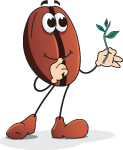|
There are 2 main species in the coffee world which are better or worse known, I dare to say, by the whole world. These are Coffea canephora , usually known as Robusta and Coffea Arabica or simply Arabica. The two types are mixed together to give the world what we know as coffee. There are some other species which are less popular because there are few places where they grow in small quantities to be commercially successful. Nonetheless it deserves mentioning it – this is coffee Liberica. Coffea arabica
Arabica green beans can also be found in Boma Plateau in southeastern Sudan and on Mt Marsabit in northern Kenya. But it is unclear whether these are native species or naturalized. Coffea Arabica is a bush which grows 9 to 12 meters tall but the height can be regulated in order to give more crops. The plant has an open branching system; its leaves are of a lustrous dark green color, have elongated form (6–12 cm long and 4–8 cm broad), and are opposite to each other. The blossom is white; the fruit is drupaceous (also called a "berry"), when it ages, its color ranges from bright red to purple and usually has two seeds (the so-called “coffee bean”).
During couple of years after planting, coffea Arabica gives yield of small and very fragrant blossom. When flowers open on a sunny day, they crop great number of small green beans or berries. This can bring to low quality coffee beans and bad harvest in the following years as the bush tends to foster berries maturing, thus injuring its health. In order to avoid this, the plants are usually pruned. Coffee blossom survives only several days and begin to fade away resulting in green berries. After awhile, the fruit begins ripening turning from green into yellow, light red and then deep red. These green coffee beans are called cherries and are ready to be picked now. The berries often ripen unevenly, thus there’s a need of hand picking to select ready beans of coffee and leave green berries to mature.
Peaberry(also caracoli) is a coffee bean. Usually coffee cherry is a fruit with two sections and 2 or even 3 beans inside it. But there are cases when only one of the two beans gets embryonated and the other vanishes. This pea-formed bean is called peaberry. Around 5% of all coffee beans yielded are green peaberry coffee beans. Kona coffee is in fact an Arabica coffee variety grown on the slopes of Hualalai and Mauna Loa in the North and South Kona Districts of the Big Island of Hawaii. Solely coffees grown in Kona regions can be added "Kona" prefix. The peculiar "Kona" climate along with its sunny mornings, thick clouds or rains in the afternoon, and a rich soil are the perfect conditions for Kona coffee beans growth.
As it is already known, canephora is easy to maintain and thus to produce. The beans are considered of lower grade if compared to Arabica beans and are often mixed with the latter to make coffee rpoduction cheaper. However it is often included in instant coffee and espresso blends to form "crema". It has a huge amount of caffeine twice as much as in Arabica coffee.
Coffea liberica
|
Coffee species: Arabica, Robusta, Liberica
Coffee species: Arabica, Robusta, Liberica


 This is the most sought after coffee specie with high quality tasting characteristics, little acidity and caffeine. Coffea Arabica is originally grown in the mountains of Yemen in the Arabian Peninsula (hereof its name - arabica) as well as the southwestern highlands of Ethiopia and southeastern Sudan. However the trees are now almost all mixed with another planted ones.
This is the most sought after coffee specie with high quality tasting characteristics, little acidity and caffeine. Coffea Arabica is originally grown in the mountains of Yemen in the Arabian Peninsula (hereof its name - arabica) as well as the southwestern highlands of Ethiopia and southeastern Sudan. However the trees are now almost all mixed with another planted ones. It takes up to 7 years for coffee Arabica to start yielding. Arabica is typically cultivated at a height of 1,300 and 1,500 m but there are species planted at the sea level and at 2.800 m height. The plant is able to stand low temperatures but not frost. It needs a little shade to be grown if opposite to Robusta which does very well under direct sun rays.
It takes up to 7 years for coffee Arabica to start yielding. Arabica is typically cultivated at a height of 1,300 and 1,500 m but there are species planted at the sea level and at 2.800 m height. The plant is able to stand low temperatures but not frost. It needs a little shade to be grown if opposite to Robusta which does very well under direct sun rays. A so-called coffee tree can give from 0.5 kg to 5kg of dried beans depending on some specific tree features and climate. Each berry typically contains two locules with 2 beans inside, though it can also contain 3 or 1 bean called peaberry.
A so-called coffee tree can give from 0.5 kg to 5kg of dried beans depending on some specific tree features and climate. Each berry typically contains two locules with 2 beans inside, though it can also contain 3 or 1 bean called peaberry.
 The Robusta bean wasn't recognized as coffee specie until 19th century, only 100 years later when same happened to Arabica. The plant has a shallow root system and grows to about 10 meters tall. It is less susceptible to climate changes, diseases and pests than Arabica bush. It gives a big crop, though it flowers irregularly and needs almost 10-11 months for cherries to ripen.
The Robusta bean wasn't recognized as coffee specie until 19th century, only 100 years later when same happened to Arabica. The plant has a shallow root system and grows to about 10 meters tall. It is less susceptible to climate changes, diseases and pests than Arabica bush. It gives a big crop, though it flowers irregularly and needs almost 10-11 months for cherries to ripen. This coffee specie was first discovered in Liberia, West Africa. It grows up to 9 meters tall and gives cherries larger than those picked from Arabica plants. The plant was brought to Indonesia at the end of the 19th century to replace the Arabica trees killed by the coffee rust disease. It is similar to Robusta beans tasting characteristics and is still found in parts of Central and East Java nowadays.
This coffee specie was first discovered in Liberia, West Africa. It grows up to 9 meters tall and gives cherries larger than those picked from Arabica plants. The plant was brought to Indonesia at the end of the 19th century to replace the Arabica trees killed by the coffee rust disease. It is similar to Robusta beans tasting characteristics and is still found in parts of Central and East Java nowadays. There is also a diversity of Liberica coffee called Baraco grown in the Philippines (provinces of Batangas and Cavite). However many traders pass off Excelsa as Baracao as its supply is limited and very expensive.
There is also a diversity of Liberica coffee called Baraco grown in the Philippines (provinces of Batangas and Cavite). However many traders pass off Excelsa as Baracao as its supply is limited and very expensive.
